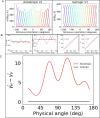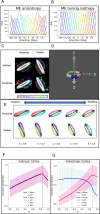This is a preprint.
Anisotropy of object nonrigidity: High-level perceptual consequences of cortical anisotropy
- PMID: 39345500
- PMCID: PMC11429613
- DOI: 10.1101/2024.09.10.612333
Anisotropy of object nonrigidity: High-level perceptual consequences of cortical anisotropy
Abstract
We demonstrate an unexpected anisotropy in perceived object non-rigidity, a higher-level perceptual phenomenon, and explain it by the population distribution of low-level neuronal properties in primary visual cortex. We measured the visual interpretation of two rigidly connected rotating circular rings. In videos where observers predominantly perceived rigidly-connected horizontally rotating rings, they predominantly perceived non-rigid independently wobbling rings if the video was rotated by 90°. Additionally, vertically rotating rings appeared narrower and longer than horizontally rotating counterparts. We decoded these perceived shape changes from V1 outputs incorporating documented cortical anisotropies in orientation selectivity: more cells and narrower tuning for the horizontal orientation than for vertical. Even when shapes were matched, the non-rigidity anisotropy persisted, suggesting uneven distributions of motion-direction mechanisms. When cortical anisotropies were incorporated into optic flow computations, the kinematic gradients (Divergence, Curl, Deformation) for vertical rotations aligned more with derived gradients for physical non-rigidity, while those for horizontal rotations aligned closer to rigidity. Our results reveal how high-level non-rigidity percepts can be shaped by hardwired cortical anisotropies. Cortical anisotropies are claimed to promote efficient encoding of statistical properties of natural images, but their surprising contribution to failures of shape constancy and object rigidity raise questions about their evolutionary function.
Keywords: Object nonrigidity; cortical anisotropy; cortical model; kinematic invariants; motion perception; shape constancy.
Conflict of interest statement
Competing interests: The authors declare no competing interests.
Figures






References
-
- Tomasi C., & Kanade T. (1992). Shape and motion from image streams under orthography: a factorization method. International Journal of Computer Vision, 9, 137–154.
-
- Aggarwal J. K., Cai Q., Liao W., & Sabata B. (1998). Nonrigid motion analysis: Articulated and elastic motion. Computer Vision and Image Understanding, 70(2), 142–156.
-
- Hildreth E. C. (1984). Computations underlying the measurement of visual motion. Artificial intelligence, 23(3), 309–354.
Publication types
Grants and funding
LinkOut - more resources
Full Text Sources
